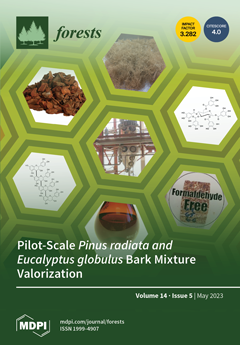Subtropical montane moist evergreen broadleaf forests (MMEBFs) have a unique environmental envelope harboring a high percentage of endemic biota. This ecosystem is highly vulnerable, and little is known about its possible response to future climate change. In this study, we used
Lithocarpus hancei (Fagaceae), a dominant tree in East Asian subtropical MMEBFs, as a proxy to investigate MMEBF distribution dynamics and key distribution restriction factors. In total, 607
L. hancei occurrence points were obtained after being gathered and filtered. The random forest model was selected as the best model. Eight environmental variables were selected to simulate the potential suitable areas of
L. hancei under the Last Glacial Maximum (LGM), present, and future (2041–2060, 2061–2080, 2081–2100) climate change scenarios, including four shared socioeconomic pathways (SSP1-2.6, SSP2-4.5, SSP3-7.0, SSP5-8.5). Our results showed that precipitation of the warmest quarter, the precipitation of the driest month, the mean diurnal range, and temperature seasonality are the key factors affecting the spatial range of
L. hancei with 11.2%, 10.9%, 8.1%, and 7.6% contributions, respectively. The current distribution of
L. hancei is mainly within East and South China, with a scattered distribution in North Indo-China and the Southeast Himalayas. The highly suitable area only accounts for 9.7% of the total distribution area. The distribution area of the current suitability area is the smallest compared to that under LGM and future scenarios. In all the future climatic scenarios, the highly suitable areas of
L. hancei would decrease or even disappear, whereas the medium- and low-suitability areas might increase with the centroid of the total suitable area northern. Its distribution in Central China, the Southern Himalayas, and Northern Indo-China will be lost in the future. Overall, our study predicted a prominent degradation of East Asian MMEBFs in the future. In situ and ex situ conservation on East Asian MMEBFs should be prioritized and enforced.
Full article





